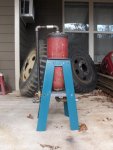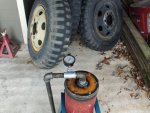Nube WMO filter Mk. II
My 5hp engine and gear head pump has worked out very well, but I was looking for a more compact filtering unit and wanted to use the cheaper filter socks in place of the expensive spin-ons. So I needed to come up with a filter-sock housing.
I used an old fire extinguisher to make the housing. I cut the bottom off, made a flange out of ½ steel and welded it to the extinguisher. Then I made a top flange from a bit of 5/16 scrap. I drilled a hole in the center to fit a 1” to ¾” pipe adapter and welded it in.
I stack three filter socks (I go down to 5 microns), pop in the 4” adapter head … slip all of that into a filter basket that I made from a piece of 4” PVC pipe (with a LOT of holes drilled in it), and a 4” PVC coupling. The adapter head threads onto a 1” nipple which in turn threads into the top flange. Then the whole thing slides into the fire extinguisher with a gasket and I bolt on the top flange using 5/16” hardware.
The intake side is on the top, the discharge is on the bottom. Shut- offs on the intake and discharge prevents drips and spills when I’m done filtering. The gauge on the intake side gives me a pretty good idea of what’s going on with the filter. The stand was just some stuff I had in the shed.
After the oil stock has been heated to about 150F using a water heater element, I let it sit a couple days to settle the water and crud out. Then I heat it back up and filter it. With temps at 120 to 150 the oil stock goes through the filter socks with no trouble … I only show about 5 to 10 PSI on the gauge. A water heater element only takes a couple hours to get the oil up to temp.
I pump it into my storage tank, let it cool, and then check the viscosity and specific gravity. I then thin it with gasoline to the range I found that the truck runs best on.
I've done a couple hundred gallons with this set up and it seems to work pretty well ... No runs , no drips, no errors.
Although a lot of folks use a 85 to 15 % mix, since I am running on whatever garage waste oil I can get, I have found that there is more performance and MPG's to be gotten if each batch of waste oil is addressed individually and blended closer to the specific gravity and viscosity of diesel. Some batches require more gasoline, others require less. Because the auto-ignition and BTU content of the WMO is so much higher than diesel, I see no need to use Diesel as a thinning agent.
I’m over 9 MPG and headed to 10. With a couple more tricks, and a little balloon footin’ on the throttle, I think I can get over 12MPG on a waste oil blend.





